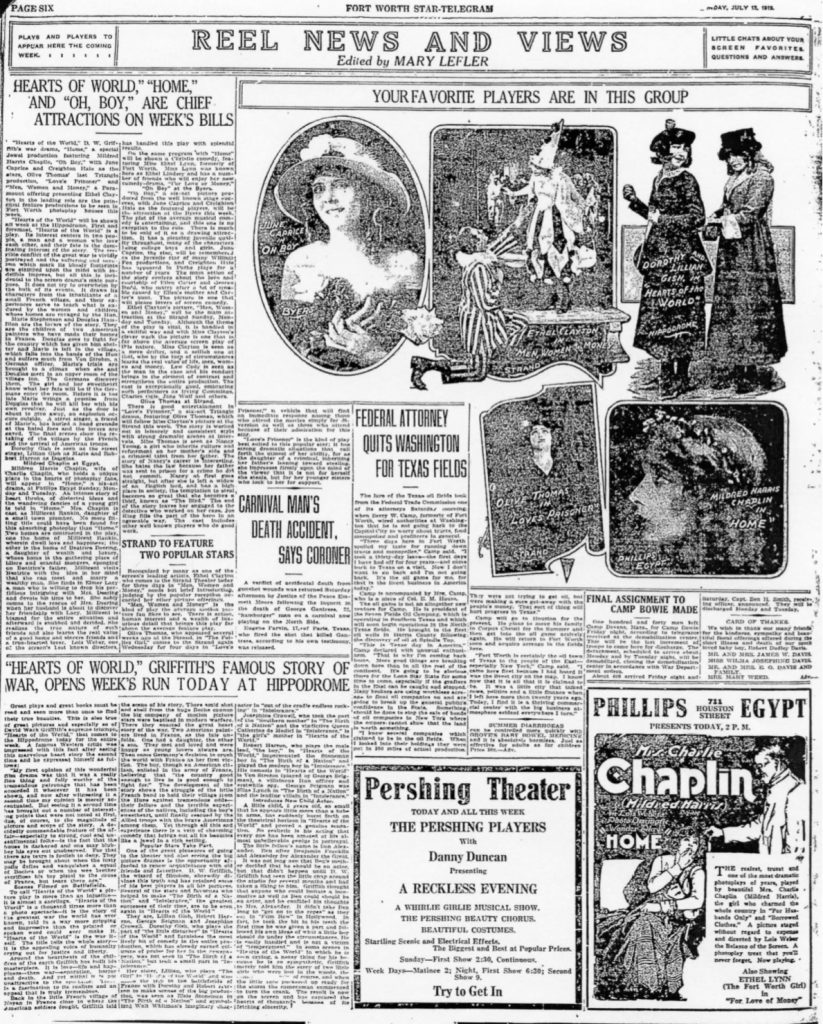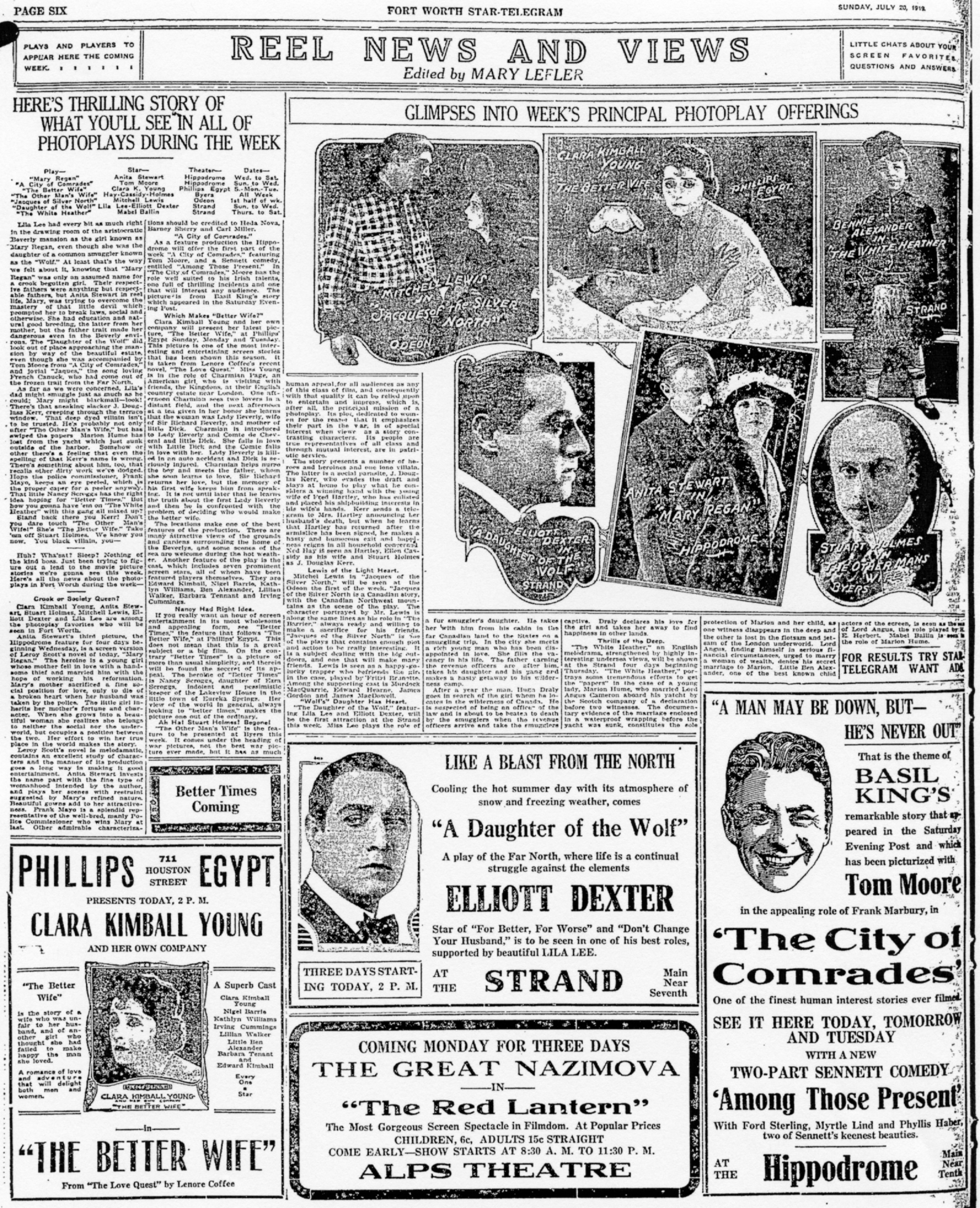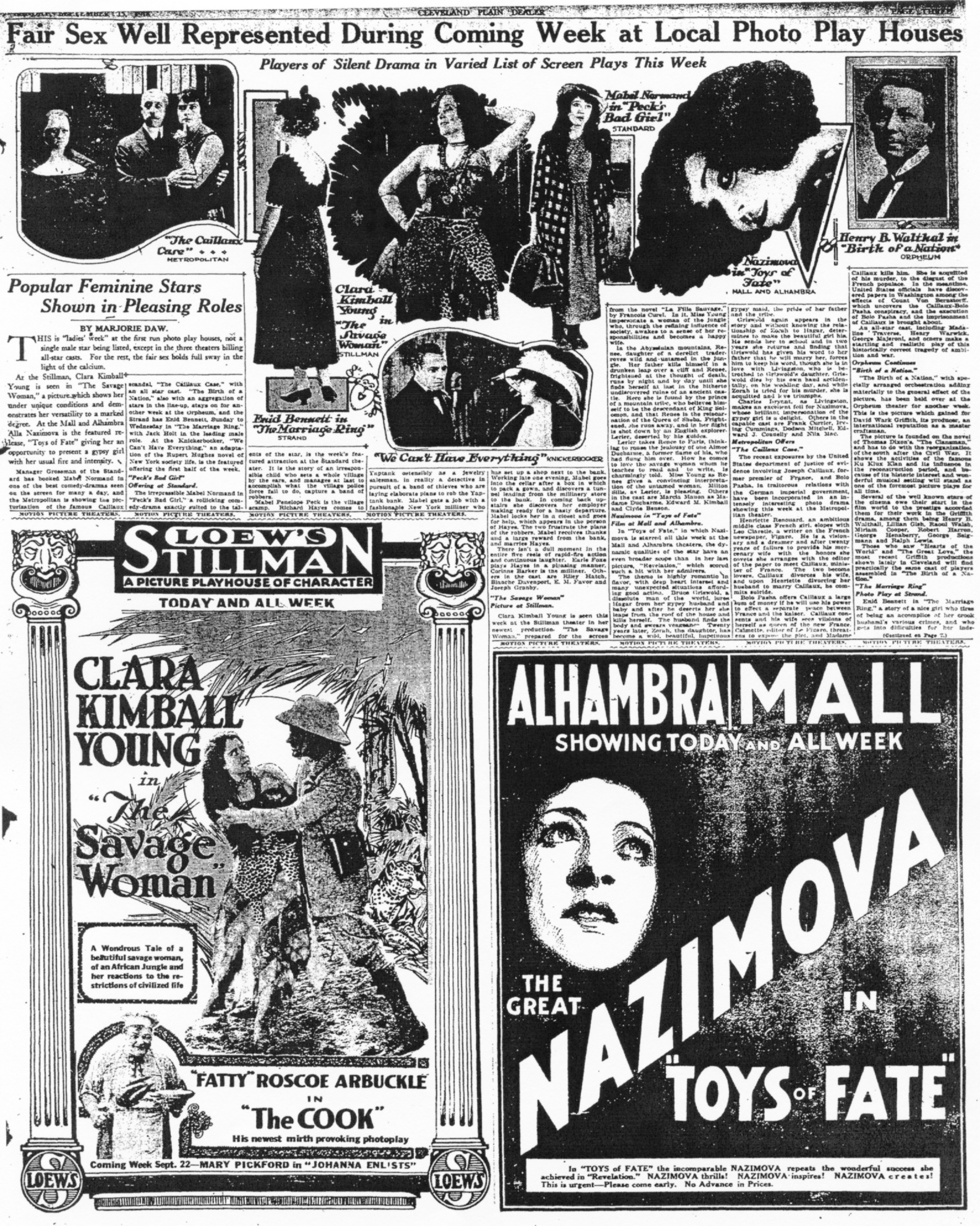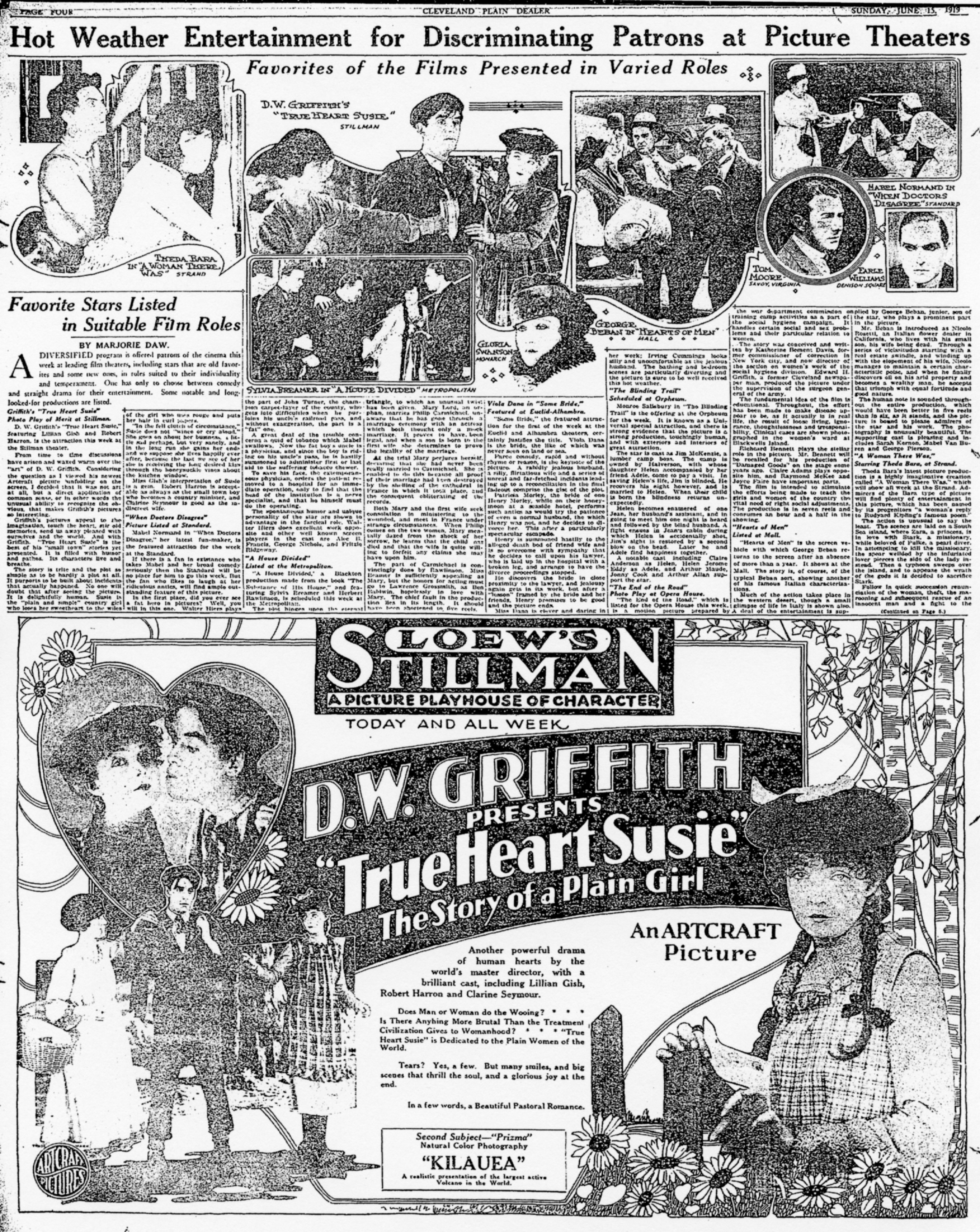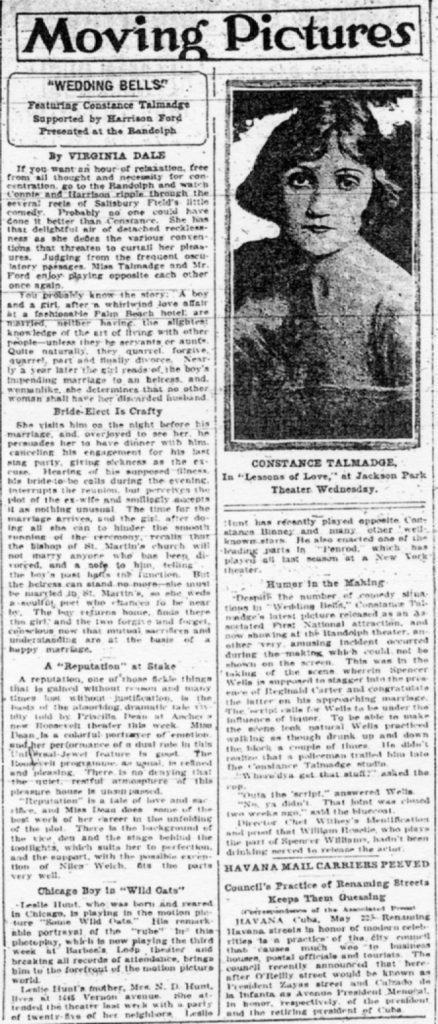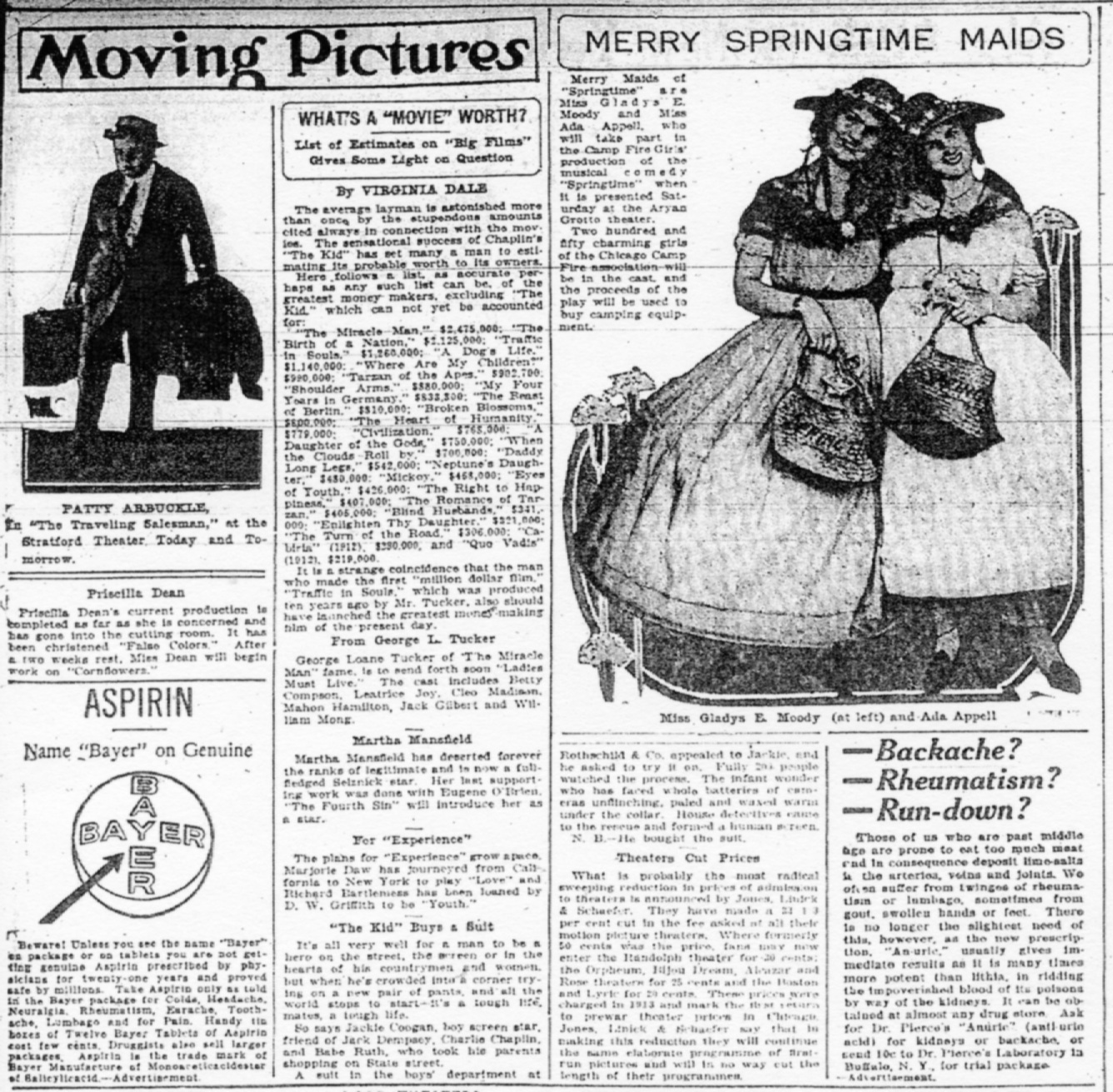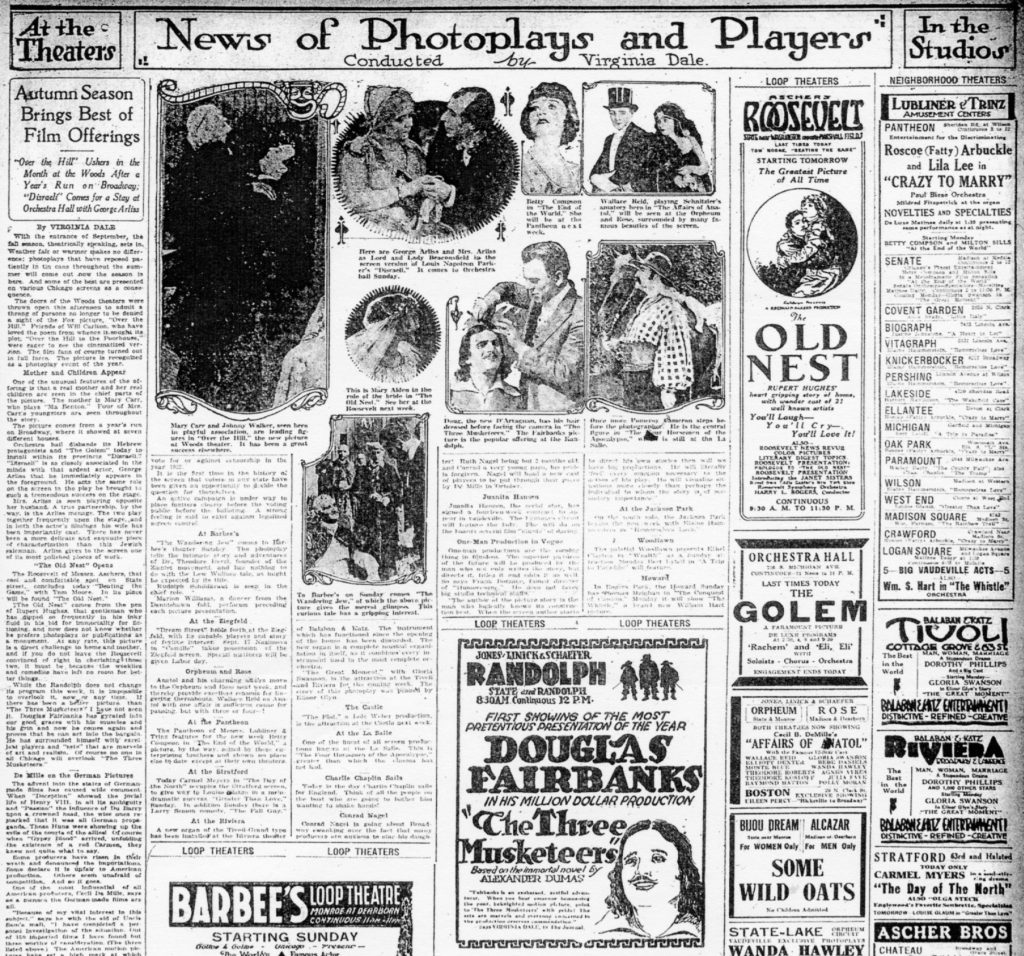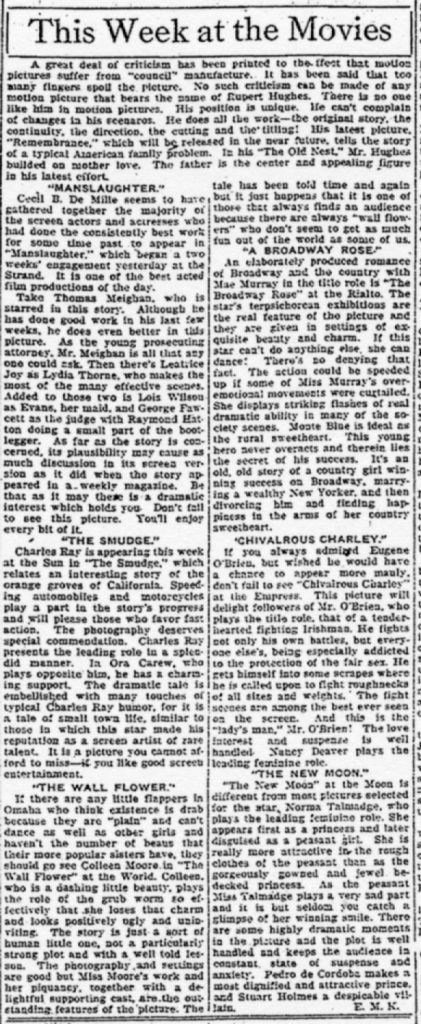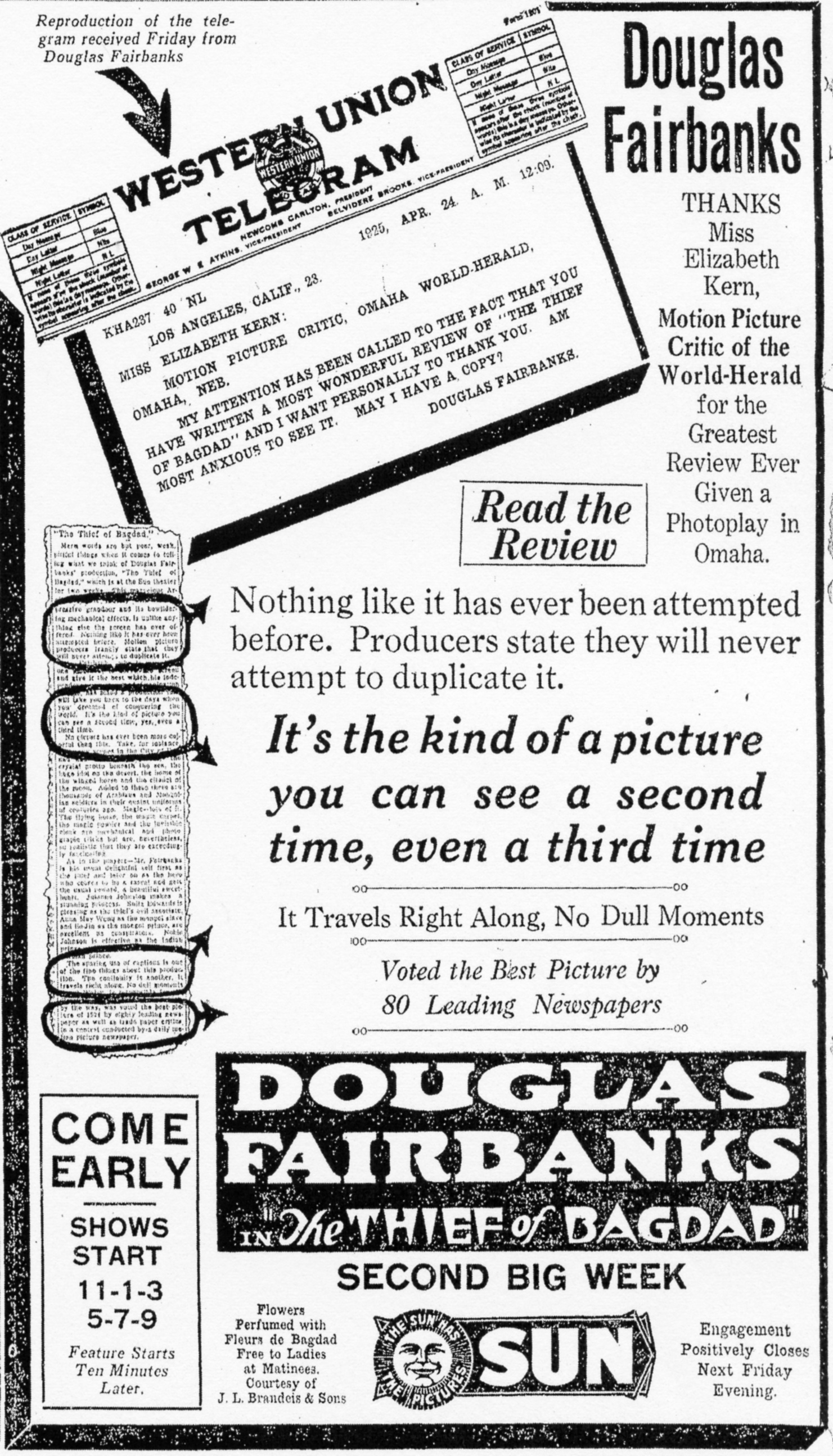Introduction
If, as Gertrude Price claimed in 1914, the movies were “a great new field for women,”1Gertrude Price, “Sees the Movies as Great, New Field for Women Folk.” Toledo News-Bee (30 March 1914): 1. that field encompassed far more than acting, which drew many star-struck girls to Los Angeles, or being hired for a range of professional positions in producing and marketing films. Indeed, extending that field to include newspapers, for instance, allows one to argue that women journalists played a significant role in the emergence of early American popular film culture in the mid-1910s.2Richard Abel, Menus for Movieland: Newspapers and the Emergence of American Film Culture, 1913-1916 (Berkeley: University of California Press, 2015). Specifically, that role involved women with writing skills who edited pages devoted to the movies in weekend newspaper editions as well as compiled gossip on stars and reviewed films, often in daily columns. In Chicago alone, at least three women quickly exerted considerable influence: Mae Tinee (Frances Peck) and Kitty Kelly (Audrie Alspaugh) at the Chicago Tribune, and Louella Parsons at the Chicago Herald. But did many women continue to write about the movies in newspapers beyond the mid-1910s; and, if they did, in which papers, in what capacities, and with what kind of impact? Samantha Barbas and Hilary Hallett, from different perspectives,3Samantha Barbas, The First Lady of Hollywood: A Biography of Louella Parsons (Berkeley: University of California Press, 2005); and Hilary Hallett, Go West, Young Women! The Rise of Early Hollywood (Berkeley: University of California Press, 2013), 71-85, 88-99. have shown that Parsons became even more influential in the late 1910s and early 19120s, but was she at all representative, one of a select few, or an anomaly? And how can a historian go about addressing such questions?
One initial source to consult might be the “First Annual Newspaper and Theater Directory” that Motion Picture News compiled in late 1919.4“Motion Picture News First Annual Newspaper and Theater Directory.” Motion Picture News (27 December 1919): 156-168. The trade journal had sent out “a questionnaire to all newspapers in cities of over twelve thousand population” in the United States and Canada and compiled a “census” of their responses. The census obviously was selective because newspapers in a great number of cities were not included, from the Tribune and Herald in Chicago or the Times in Los Angeles to the Constitution in Atlanta or the Herald in Syracuse—belying the trade journal’s claim that those not responding seemed to have no interest in motion pictures. In the case of Chicago, Mae Tinee continued editing and reviewing at the Tribune through the 1920s; Kitty Kelly wrote reviews for the Examiner at least through 1918; and Parsons that year moved to the New York Telegraph. Moreover, most of the hundreds of “photoplay editors” or writers listed had only initials and last names, so that the two dozen with definite women’s names may have been a fraction of the real number.5Among those were Mary Connelly of the Elmira [New York] Herald, Elida Bedell of the Bridgeport [Connecticut] Post, Pauline Brady of the Brockton [Massachusetts] Times, Mary Ley of the Akron [Ohio] Times, May Cameron of the Evansville [Illinois] Press, Mrs. M.M. Wallace of the Beloit [Wisconsin] News, Mrs. Leonora Fishel of the Denver Express, and Mrs. Alida F. Sims of the Albuquerque Herald. An added problem arises when one searches the Internet for digital copies of those women’s newspapers; then, the number of confirmed writers is reduced to no more than a few. Still, those few that are accessible allow one to gain a very limited sense of how women were writing about the movies in the period of 1918-1919.
Newspaperwomen and the Movies in the USA
Two of those women were already familiar to their newspaper readers. For the New York Sunday Tribune, Harriette Underhill had been writing a weekly column since late 1916 based on lengthy interviews with a single actor or actress.6Abel, Menus for Movieland, 169. According to the Motion Picture News directory, the New York Tribune’s circulation numbers were 110,000. In Ishbel Ross’s words, Underhill “was cynical to the core, scorned sentiment, [and] had a sophisticated wit,” but the interviews, full of dialogue in which she engaged with her subjects as “we” or an inquisitive “visitor,” also revealed that she could be generous and unobtrusive.7Ishbel Ross, Ladies of the Press: The Story of Women in Journalism by an Insider (New York: Harper & Brothers, 1936), 412-413. After touring as a stage performer, Underhill took over writing her father’s sports column in the Tribune (after his death) before introducing her movie interview column. She suffered from tuberculosis and died in 1928. In late 1918, after the peak of the influenza epidemic, she let Enrico Caruso talk about his career by describing the photos, books, and scrapbooks in his hotel suite and then open his mail and comment on one or more letters from fans.8Harriette Underhill, “How to Fill in the Time Until Caruso Arrives.” New York Sunday Tribune (8 December 1918): 4.5. Others Underhill interviewed ranged from D.W. Griffith in rehearsal or “Bill” Hart, who acknowledged the cowboy Snowy Baker as an inspiration, to Bryant Washburn whose fans wondered if his dimple was real or painted on.9Harriette Underhill, “Snowy Baker Fires Bill Hart’s Ambitions.” New York Sunday Tribune (19 January 1919): 5.4; “Some Startling Information Anent Bryant Washburn.” New York Sunday Tribune (26 January 1919): 4.4; and “David Wark Griffith Agrees The Play Is Not the Thing.” New York Sunday Tribune (12 October 1919): 4.6. The latter interview led her to briefly take up similar questions from fans: is Olga Petrova’s figure “all her own”; “how tall [is] Marguerite Clark”; does Douglas Fairbanks “act like that in real life”; does Bill Hart “have any one to double for him”? Searching for Underhill’s interviews also turns up another column on the same page in the Tribune written by Virginia Tracy. While Tracy sometimes did profiles—i.e., of Fairbanks or director Maurice Tourneur—she more often addressed broader issues—i.e., intellectuals’ persistent disdain for the movies; the “curse of sweetness” for ingénues; or the need for more than plot to make a good picture.10Virginia Tracy, “And Still No Surrender By the Intellectual.” New York Sunday Tribune (8 December 1918): 4.5; “The Curse of Sweetness Laid Upon Ingenues.” New York Sunday Tribune (12 January 1919): 5.5; “More Than Plot to Make a Picture” New York Sunday Tribune (19 January 1919): 5.4; “The Dazzling Sameness of Douglas Fairbanks.” New York Sunday Tribune (26 January 1919): 5.4; “Tourneur Brings An Old Melodrama Back to Life.” New York Sunday Tribune (5 October 1919): 4.8. She even offers a lengthy review or two, as in her pithy put down of A Scream in the Night (1919): The heroine “is very pleasant to look at, swaying and flashing about in the jungle on her rope of moss, but as soon as she comes down to earth she shows us that her wildness is of the hop, skip, and a jump variety.”11Virginia Tracy, “A Monk, a Girl and Thrills.” New York Sunday Tribune (12 October 1919): 4.6. For reasons yet to be determined, neither woman’s byline appears in the Sunday Tribune after early November 1919.
For the Fort Worth Star-Telegram, a young journalist, Mary B. Lefler, had been writing two daily columns, “Flashes from Filmland” and “Gossip of the Film World,” beginning in the summer of 1914, and then editing a full Sunday page, “In the Photoplay World,” by the following summer. Four years later, under her own byline, she still was editing that same Sunday page, now headed “Reel News and Views” of the “plays and players to appear here the coming week.”12“Reel News and Views Edited by Mary Lefler.” Fort Worth Star-Telegram (7 July 1918): 30. Lefler’s first position on the paper was as the “circulation bragger” of the “Sunday Sandwich”—four columns of miscellany on the editorial page. According to the Motion Picture News directory, the Star-Telegram’s circulation numbers were 62,125 daily and 65,00 on Sundays. Among the star photos, theater ads, and stories (probably summarized from publicity material shared by those advertising theaters) was a column, “Reel-Y True,” that fulfilled the promise of “little chats about your screen favorites [with] questions and answers.”13“Reel News and Views Edited by Mary Lefler.”Fort Worth Star-Telegram (15 September 1918): 31. By summer 1919, Lefler’s coverage of the movies—apparently compiled from the trade press, fan magazines, and studio publicity—included part of a second page, and she gave special attention to Griffith’s “supreme triumph,” Hearts of the World (1918), in a separate article that added to the distributed publicity a quoted paragraph of high praise from an unnamed “famous Western critic.”14“Reel News and Views Edited by Mary Lefler.” Fort Worth Star-Telegram (13 July 1919): 2.6-7. On page 6, the highlighted article was “‘Hearts of the World’ Griffith’s Famous Story of War, Opens Week’s Run Today at Hippodrome.” In late August, “Reel News and Views” turned into “At the Movies,” with the same kind of photos, ads, and stories, including the “Reel-Y True” column and one or more ads that ran onto a second page.15“At the Movies.” Fort Worth Star-Telegram (31 August 1919): 2.6, and (21 September 1919): 2.6-7. But Lefler’s byline had disappeared; if someone replaced her, that writer went unnamed.
One woman not listed in the Motion Picture News directory would have been familiar to readers of the Cleveland Plain Dealer, where Harlowe R. Hoyt, in the fall of 1917, had expanded its Sunday coverage of the movies to three pages—with lots of photos, half a dozen or more theater ads (often large), a syndicated gossip column from “Gertrude,”16This “Gertrude” wrote from New York, so she was not Gertrude Price, who was based in Los Angeles by this time. and other regular columns (among them, one bylined “The Answer Man”). In June 1918, Marjorie Daw introduced a column profiling people in the industry with links to Cleveland;17Marjorie Daw, “Cleveland Youth Wins Fame in Screen World.” Cleveland Sunday Plain Dealer (9 June 1918): Editorial/Dramatic, 5, and “Famous Director of Films Claims Cleveland as Home.” Cleveland Sunday Plain Dealer (16 June 1918): Editorial/Dramatic, 5. She also wrote a profile of Lieutenant Pierre Daye who was visiting the city after serving with the Belgian Army in the Congo—Marjorie Daw, “Belgian Hero of African War Visits City.” Cleveland Sunday Plain Dealer (17 November 1918): 1.8. that fall, when Hoyt turned to editing the theater pages, Daw assumed his former position as photoplay editor.18 Marjorie Daw, “Players of Shadow World Undimmed by Autumn Days.” Cleveland Sunday Plain Dealer (1 September 1918): Editorial/Dramatic, 4. Like Lefler, Hoyt, and other such editors, Daw compiled columns of publicity material and wrote up summary program descriptions supplied by the theaters sponsoring these pages with ads. Additionally, she framed those summaries with chatty, playful introductions.19Daw, “Players of the Shadow World Undimmed by Autumn Days,” 4, and “Stars of First Magnitude Seen in Plays That Suit.” Cleveland Sunday Plain Dealer (24 August 1919): Editorial/Dramatic, 4. In mid-September 1918: “This is ‘ladies week’ at the first run photoplay houses, not a single male star being listed…the fair sex holds sway…”20Marjorie Daw, “Popular Feminine Stars Shown in Pleasing Roles.” Cleveland Sunday Plain Dealer (15 September 1918): Editorial/Dramatic, 3. In late November 1918: “By their stars ye shall know them—the movies! The best story, the wisest direction, the most splendid settings, the wildest of scenery, the most costly of stagings, will avail nothing if the star be not popular.”21Marjorie Daw, “Real Merit in Pictures Offered at Local Houses.” Cleveland Sunday Plain Dealer (24 November 1918): 3.4. In June 1919: “Summer is with us once more in theory as well as fact…In the words of Kipling, [some may] exclaim ‘It’s pretty, but is it art?’ The real movie fan doesn’t worry about anything so banal.”22Marjorie Daw, “Every Cinema Has Its Day During Sultry Months.” Cleveland Sunday Plain Dealer (1 June 1919): Editorial/Dramatic, 4. Daw also voiced her own impressions of films for readers, as in her concise comments one week on John Barrymore and Douglas Fairbanks.23Daw, “Players of Shadow World Undimmed by Autumn Days,” 4. In the stage adaptation, On the Quiet (1918), “Barrymore’s skill as a comedian saves the picture from a single dull moment.” A “typical” Fairbanks vehicle, Bound in Morocco (1918), has “a paucity of plot, perhaps, but plenty of action, unusual situations, and numerous ‘stunts.’” A few weeks later, she noted the “little German plot” added to the western, Mr. Logan U.S.A. (1918), in which Tom Mix wraps up the film by “capturing a girl and a spy with the same rope.”24Marjorie Daw, “List of Film Favorites Billed for This Week.” Cleveland Sunday Plain Dealer (22 September 1918): Editorial/Dramatic, 3. By the summer of 1919, she had a weekly column of local movie news, one of which reported an interview with Clara Joel and Maggie, her pedigree bulldog, registered as “Marjorie Daw.”25Marjorie Daw, “What’s Doing in Photo Play.” Cleveland Sunday Plain Dealer (24 June 1919): 14. Clara Joel acted in both theater productions and motion pictures. That earned the quip: “one Marjorie at least is registered.” In September, Hoyt returned as Sunday photoplay editor, and Daw’s name, like Lefler’s, disappeared from the newspaper.
Although one obviously has to question how representative these four women may be, their disappearance as newspaper editors, columnists, and reviewers in 1919 does pose a puzzle. And that puzzle has an uncanny parallel, around the same time, in the declining number of women who could work as filmmakers in the industry. Karen Ward Mahar was one of the first to highlight this decline and the broader phenomenon of an increasingly gendered division of labor defining the industry as big business.26Karen Ward Mahar, Women Filmmakers in Early Hollywood (Baltimore: Johns Hopkins University Press, 2006). Accepting in part her argument that this division was due to the impact of finance capital, Mark Cooper examines the case of Universal, which employed the most women directors in the 1910s, and argues that the development of more standardized genre conventions was equally important, linking women filmmakers to an outmoded concept of the “woman’s film,” with the result that the company released not a single film credited to a woman director in 1920.27Mark Garrett Cooper, Universal Women: Filmmaking and Institutional Change in Early Hollywood (Champaign: University of Illinois Press, 2010). In the specific case of Lois Weber, Universal’s highest salaried director at one time, Shelley Stamp attributes her marginalization in the late 1910s not only to the formation of her own independent company (affiliated initially with Universal) but also to her choice of directing films that critiqued the American consumer society of which the movies were a crucial part.28Shelley Stamp, Lois Weber in Early Hollywood (Berkeley: University of California Press, 2015). A gendered division of labor also may have characterized the newspaper industry, for it seemed to mark most newspapers’ coverage of the movies, according to that Motion Picture News directory.29That directory listed several hundred editors and writers, the vast majority men. Although the cause of this apparent decline in the number of women editors and writers in the late 1910s may be beyond the scope of this short essay, one can wonder whether, besides the increasing influence of finance capital and institutional professionalization, other systematic socio-economic changes and masculinizing cultural patterns following the end of the Great War and the return of American soldiers had just as much impact.30See, also, for instance, Ruth Oldenziel, Making Technology Masculine: Men, Women, and Modern Machines in America, 1870-1945 (Amsterdam: Amsterdam University Press, 1999). Still, a later source, a 1926 New York Film Arts Guild document, seems to question that decline, suggesting that their number actually may have increased in the 1920s. For, of the fifteen film reviewers affiliated with newspapers that were named as members of the guild’s Advisory Council, at least six were women.
Refocusing attention on Chicago in the early 1920s, one finds that women continued to edit pages and/or write columns devoted to the movies in most newspapers.31Others, besides Mae Tinee at the Chicago Tribune, included Genevieve Harris at the Chicago Post and theater critic Amy Leslie eventually at the Chicago News. Virginia Dale, for instance, whom the Motion Picture News had named as photoplay editor of the Chicago Journal,32See also a reprint of Dale’s review of Griffith’s Broken Blossom (1919) in “New Picture Adds Fame to Griffith.” Fort Wayne News and Sentinel (18 October 1919): 2.12. held that position at least through 1925, editing the Saturday edition’s “News of Photoplays and Players” page and writing a daily film review column.33“News of Photoplays and Players Conducted by Virginia Dale.” Chicago Journal (27 August 1921): 9; and Virginia Dale, “Moving Pictures.” Chicago Journal (1 June 1921): 8. According to the Motion Picture News directory, the Journal’s circulation numbers were 118,000. No copies of the Chicago Journal survive at the Chicago Historical Society Library before June 1921; the Saturday page initially was simply bannered “Movies,” with Dale’s byline. For the purposes of this short essay, my analysis of Dale’s work focuses on the months of June through September 1921. Each Saturday, Dale’s long column compiled not only gossip of the stars and brief notes on major theater programs but also discussed current issues such as Carl Laemmle’s effort to educate censorship boards, industry leaders testifying in Congress against “the 5 percent film rental tax” (a carry over from the war), and the “menace” of German film imports—i.e., Passion (1925), Deception (1920), and The Golem (1915)—denounced by no less than Cecil B. DeMille.34Virginia Dale, “Autumn Season Brings Best of Film Offerings.” Chicago Journal (3 September 1921): 7. Passion, with Nazimova, was still playing at the downtown Rose in early June; Deception, “with Henny Porten and Cast of 7000,” played for a week at the downtown Roosevelt in early August; and The Golem had a two-week run at the Orchestra Hall through late August. As for her reviews, the Journal promoted those with frequent ads.35See, for instance, the ads in the Chicago Journal (6 June 1921): 11, and (18 June 1921): 8. Some highlighted the personal attraction of certain stars: in Wedding Bells (1921), Constance Talmadge displays “that delightful air of detached recklessness as she defies the various conventions that threaten to curtail her pleasures”; in Salvage (1921), Pauline Frederick is “a deeply intense, vividly emotional actress, playing as she loves to play, running the whole gamut of human emotions as she unfolds the involved threads of this rather improbable drama.”36Virginia Dale, “Moving Pictures.” Chicago Journal (7 June 1921): 9, and (8 June 1921): 8. Others could be unkind even to a film by Lois Weber. Too Wise Woman (1921), “another effusion from the workshop of Lois Weber,” sadly, had “a too superficial thought structure on which to build and project ideas.”37Virginia Dale, “Moving Pictures.” Chicago Journal (9 June 1921): 10. By contrast, The Woman God Changed (1921) she thought would only have “an appeal for those who like their religion sugar-coated and who swallow an idea whole.”38Virginia Dale, “‘Woman God Changed’ Now at Randolph.” Chicago Journal (2 July 1921): 8. One of Dale’s more interesting columns showed how closely she was connected to the industry by printing “a list, as accurate as any such list can be, of the greatest money-makers” among American films.39Virginia Dale, “What’s a ‘Movie’ Worth?” Chicago Journal (10 June 1921): 13. The top five were The Miracle Man (1919) ($2,475,000), Birth of a Nation (1915) ($2,125,000), Traffic in Souls (1913) ($1,260,000), A Dog’s Life (1918) ($1,140,000), and Where Are My Children? (1916) ($990,000)—but she was silent on the source for these figures.
Finally, one of the six newspaperwomen named as members of the New York Film Art Guild’s Advisory Council was Elizabeth Kern, a young writer for the Omaha World-Herald. Like many other papers, the World-Herald had covered the movies extensively since the mid-1910s. By summer 1922, that coverage included not only several Sunday pages (no editor was named) but also a Monday review column, “This Week at the Movies,” signed by A.H.M.40“Movies.” Omaha Sunday World-Herald (6 August 1922): E.9; and A.H.M., “This Week at the Movies.” Omaha World-Herald (7 August 1922): 3. A.H.M. remains unknown. At the same time, the paper was running a syndicated series, “Opportunities for Women in the Movies,” that for each of seventeen weeks through November focused on a single industry position and one exemplary woman.41See, for instance, “Opportunities for Women in the Movies: V. Scenario Writer.” Omaha World-Herald (27 August 1922): E.10; and “Opportunities for Women: VI. Publicity Writer.” Omaha World-Herald (3 September 1922): E.9. Other positions singled out were secretary, location finder, continuity writer, film editor, production manager, teacher, continuity clerk, assistant director, hairdresser, director, artist in an art department, and musician. The example for a director was Dot Farley, who worked for Mack Sennett. In the midst of this series, in mid-September, Kern took over the film review column with a slangy riff on Rudolph Valentino’s rift with Famous Players: “This famous he-vamp announces that he will ‘take his doll rags and go home’ if the business of publicity and advertising doesn’t straighten out.”42E.M.K., “This Week at the Movies.” Omaha World-Herald (18 September 1922): 6. E.M.K. became Elizabeth Kern sometime in 1923. That first week, while praising Grandma’s Boy (1922) as “the best picture Harold Lloyd ever made,” Kern seemed ambivalent about the “regular fashion show” in No Trespassing (1922), where Irene Castle showed off “evening gowns, the smartest of street dresses, riding and bike outfits, and motoring garb.”43E.M.K., “This Week at the Movies,” 6. The following week she exhorted “any little flappers in Omaha who think existence is drab [to] go see Colleen Moore in The Wall Flower [1922]…”44E.M.K.,“This Week at the Movies.” Omaha World-Herald (25 September 1922): 2. She also could pan a film like Devotion (1920), starring Hazel Dawn, “an outstanding example of what we mean when we say motion picture hash, with all the melodramatic punch of the old ten-twenty-thirty shows…”45E.M.K., “This Week at the Movies.” Omaha World-Herald (9 October 1922): 3. Intriguingly, Kern also drew on trade press and other sources to “teach” Omaha fans about the movies. She reported on Will Day’s London “exhibition of moving picture relics,” reprinted an interview with Alvin Wyckoff in which he made trenchant comments on “atmospheric lighting,” and challenged them to see how a film like The Impossible Mrs. Bellew (1922) seamlessly integrated location and studio shots within a scene.46E.M.K., “This Week at the Movies.” Omaha World-Herald (9 October 1922): 3, (23 October 1922): 7, and (30 October 1922): 7. In classifying fans one week, she even used the pronoun, “He,” whether as a sign of accepting the masculine conventions of discourse at the time or as an explicit means of enticing more men in Omaha to become moviegoers.47E.M.K., “This Week at the Movies.” Omaha World-Herald (6 November 1922): 3. Most cinema historians agree that women comprised the majority of moviegoers in the 1920s, and most likely even earlier. By 1925, Kern’s reputation was such that Douglas Fairbanks sent her a telegram personally thanking her for “a most wonderful review of ‘The Thief of Bagdad.'”48The Sun theater reproduced this telegram in a large advertisement in the Omaha World-Herald (26 April 1925): E.8.
In 1914, Gertrude Price’s claim had merit—the movies indeed were a great new field for women—a field that definitely included professional writing for the newspapers. But would that claim have held up five or ten years later? The answer, at least for now, has to be inconclusive—and the reasons, one way or another, speculative. While some women like Mae Tinee and Parsons enjoyed “starring roles” for more than a decade, others such as Underhill, Tracy, Lefler, and Daw apparently left the spotlight, perhaps not of their own volition. New recruits like Dale, Kern, and others may have heralded a new generation of women editors and reviewers in the early 1920s, and others may remain “hidden” behind the apparent practice that had writers identified only by last names and first name initials. Furthermore, were the targeted readers/fans of these new recruits largely women or, rather, were they just as often men; if the latter, did the reviews and commentary seeming to address them complement an apparent industry strategy that sought to broaden and transform what was assumed to be a predominantly female audience for the movies? More definite answers will depend in part on future researchers continuing to construct useful databases not only by accessing and reliably searching more and more digitized newspapers but also by “getting dirty,” that is, examining all kinds of material remains in local and regional libraries and consulting with their knowledgeable curators. Perhaps this short essay will have turned up more clues for them to follow and that may lead to even more challenging questions, given the sources referenced, the women writers briefly studied, and those with unfamiliar names much in need of becoming more known.49All images used in this essay are already cited in the text, except for the following: Mary Lefler, “Reel News & Views.” Fort Worth Star-Telegram (20 July 1919): 3.6; Marjorie Daw, “Favorite Stars Listed in Suitable Films.” Cleveland Plain Dealer (15 June 1919):4; E.M.K., “This Week at the Movies.” Omaha World-Herald (27 August 1923):9.
See also: Special Dossier on Early US Newspaperwomen
.

